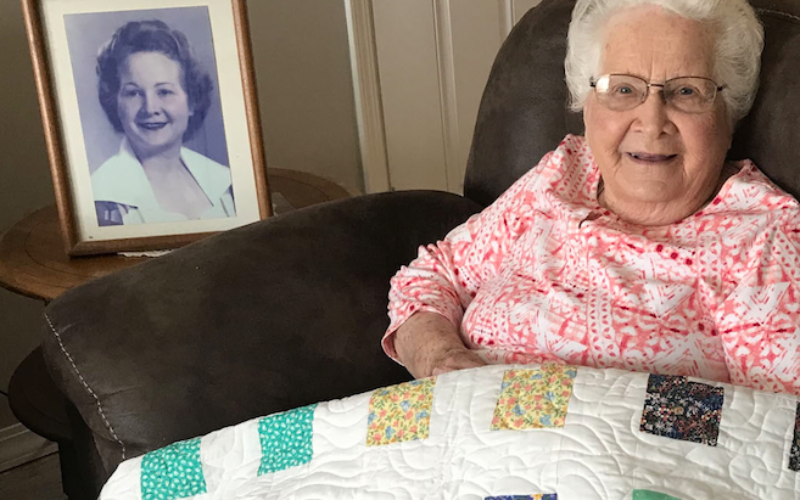At 95, Willa Fouty is real live ‘Rosie the Riveter’
BECCA MARTIN-BROWN
bmartin@nwadg.com

Photography by Dwight Primiano; courtesy Crystal Bridges Museum of American Art
“Rosie the Riveter,” an oil on canvas painted in 1943 by Norman Rockwell (1894-1978), became an iconic image of women’s changing roles during World War II. The original painting is part of the permanent collection at Crystal Bridges Museum of American Art in Bentonville. March 21 was National Rosie the Riveter Day, declared by the American Rosie the Riveter Association.
Sometimes heroes — or heroines — hide in plain sight. Some folks who know Willa Fouty know she sews avidly, making quilts for tiny patients at Arkansas Children’s Hospital. Others might remember her as a great cook. Still others might be aware she’d “rather dance than eat” and made all the costumes for the years she square danced. And anyone who has met her knows she raised three much loved children who idolize their mama.
But it’s a good bet very few people in Springdale know that Fouty was a heroine of World War II. She worked for a brief time building B-25s at North American Aviation Inc. in Kansas City, Kan., then for a year at Goodyear Aircraft Corp. in Phoenix as a riveter and finally an inspector. At 95, she is one of the increasingly rare “Rosie the riveters.”
Fouty has long been a member of the American Rosie the Riveter Association, and she always hoped she’d get to attend one of the organization’s conventions and meet other Rosies. But she never thought she’d sit down and tell her story to a reporter. She never thought she was any big deal.
“At the time, I was quite proud to think I was helping with the war,” she remembers. “But everyone who could, did.”
An Unsung Heroine
Fouty’s story is fascinating simply from the perspective of 2019. She was born Jan. 2, 1924, next to last of 13 children of farmers William Truman Ratliff and Wilma Adela Brown in a community called Forks of the River north of Trenton, Mo. They didn’t have electricity or running water, and she walked over a mile to a “little bitty country school” — but only through ninth grade. She says she “never got to get an education,” but it’s clear that she learned everything she needed to know over the years. Settled comfortably in a beautiful home she shares with daughter Rose Lawrence in a new senior living subdivision in Springdale, she keeps her iPad close at hand and proudly says she has been on Facebook since she was 88. It’s a good way to keep up with her five grandchildren, nine great-grandchildren and and four great-great-grandchildren.

Photos courtesy Willa Fouty
Willa Fouty always made matching dresses for her daughters Jan and Rose. Kevin, her middle child and only son, died in 2018.
Fouty married at 17 and moved with her husband, Charlie Allison, to Phoenix for his health; he had tuberculosis. It was there that she worked for Goodyear Aircraft Corp., and she loved every minute of her life in the desert.
“It was the prettiest place I’d ever seen,” she says. “I loved the orange trees and the grapefruit trees and the cactus in bloom. I’d take a long walk every morning just to enjoy the beauty of it.”
While her memory is still sharp, Fouty says she doesn’t recall that much about her job. History says the plant in Phoenix built B-26 Marauders, but what Fouty does remember clearly was that she enjoyed being an inspector “because I got to see everything.” She also remembers being terribly homesick, and she intended to return to Missouri when Charlie succumbed to his illness. She was between one home and the other when she got off the train in Liberal, Kan., to stay with her sister for awhile. It was there she met her second husband, Willard Lee Snow, the father of her three children.
Oldest daughter Jan Mulvania jumps in to talk about her mother’s years helping support the family by cooking at The Crown restaurant in Trenton.
“She was a fantastic cook,” Jan says, describing “humongous” cinnamon rolls that were 50 cents. She also enjoys explaining that Fouty made matching dresses for Jan and sister Rose, who were only 15 months apart.
“My delight was to dress my two little girls,” Fouty admits with a grin.
Jan pulls out photos of the family, and Fouty’s ready smile fades. Her last sibling, Jay Ratliff, died in February 2018 and her son Kevin was struck down by a heart attack in April of that year. “It almost killed me,” Fouty says simply. But the new home she shares with daughter Rose seems to have cheered her. They created a large and well-appointed sewing room for the hobby they share, with closets full of neatly stored fabric, and Fouty is currently working on another quilt for Arkansas Children’s Hospital.

Photos courtesy Willa Fouty
Willa Fouty always made matching dresses for her daughters Jan and Rose. Kevin, her middle child and only son, died in 2018.
“I’ve learned and continue to learn so much from my mom,” says daughter Rose, who is administrative assistant to the mayor of Springdale. “She is such a sweet and kind lady, and what a sense of humor she has, managing to keep all of us on our toes when she is around! She has been through so much during her lifetime but is one of the strongest women I know and has accomplished so much on her own.
“She is so proud of her time as a ‘Rosie’ and knows that although it may not have been as long as some people, she did a service during wartime.”
The Birth Of Rosie
The character of “Rosie the Riveter” was born in 1942, when songwriters John Jacob Loeb and Redd Evans “wanted to write a song about women who were working for the war effort for the country,” music historian Robert Lissauer told author Penny Colman in a 1994 interview.
“So they just made up the name ‘Rosie the Riveter.’ You pick a name for the alliteration and you go ahead and write it,” The Washington Post reported the story in September 2018. “By ‘working overtime on the riveting machine,’ the song says, Rosie protects her boyfriend, a Marine named Charlie who’s fighting in the war. She even wins an ‘E’ — the Army-Navy Excellence in Production award,” The Post wrote.
The Four Vagabonds recorded “Rosie the Riveter” in January 1943, and four months later, on May 29, 1943, the Saturday Evening Post published a cover image by Norman Rockwell, described by The Washington Post as “a painting of a red-haired woman in denim work clothes, eating a sandwich on her lunch break, cradling an enormous rivet gun in her lap.”
That’s the Rosie best known in Northwest Arkansas. Rockwell’s original painting is on exhibit at Crystal Bridges Museum of American Art, one of the pieces acquired by the museum before it even opened.
Jen Padgett is assistant curator at Crystal Bridges, and her focus is on the early 20th century, “so Rosie comes right from that period.” And she is more than a little passionate about the painting, describing it as “a really special and important work.” An oil on canvas, Rockwell’s painting was donated to the U.S. Treasury Department for use in war bond drives. As a result, says Padgett, it was raffled off, then later acquired by a tool manufacturing company. In 2002, it was auctioned at Sotheby’s for nearly $5 million, then acquired by Crystal Bridges in 2009.
Seventy-five years after its creation, Padgett says, “Rosie” resonates with viewers because of its message of “empowerment, the idea that women can do any kind of job that men can do. It was an important moment in history that recognized women as powerful figures.”
Padgett wants viewers to see the details, references to femininity in the compact and handkerchief in Rosie’s pocket, “even while she’s wearing this rough denim with cuffed legs.” She’s also got her foot on a copy of Hitler’s Mein Kampf — “a direct connection to the reason the United States was at war,” Padgett says — and wears a selection of lapel pins promoting the war effort.
“It’s such an iconic work,” Padgett says. “For me, it’s the complexity — the longer you look at it, the more things you notice. I love the striking quality, the imposing, monumental figure that Rockwell based on the Prophet Isaiah from Michelangelo’s Sistine Chapel ceiling, but then there are all the details. He was so intentional about all his decisions, such as the halo above her head that makes it clear he’s setting her up as almost a saintly figure.”
Right now, Rockwell’s painting is part of the temporary exhibit “Men of Steel, Women of Wonder” at Crystal Bridges. Coincidentally, the American Rosie the Riveter Association declared March 21 National Rosie the Riveter Day, hoping any women who worked “in manufacturing, munitions plants, shipyards, aircraft assembly factories, for the Red Cross or perhaps volunteering in some capacity, even collecting scrap metal as a child” or their descendants will join the organization.
“Each day, we lose the opportunity to honor these remarkable women and collect their stories for future generations,” says ARRA President Donnaleen Lanktree.
__
Read More About It
American Rosie the Riveter Association
RosietheRiveter.net or (888) 557-6743










